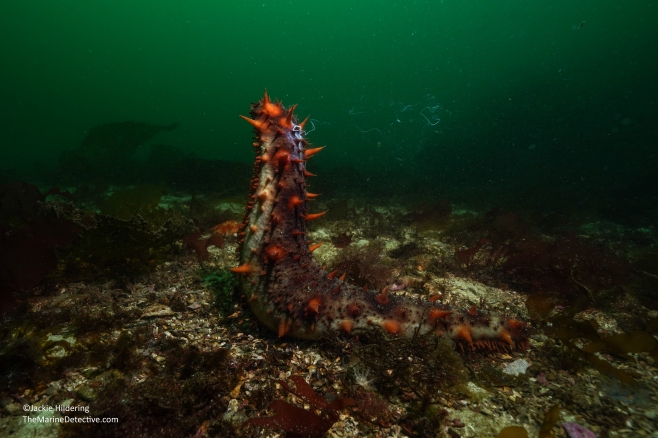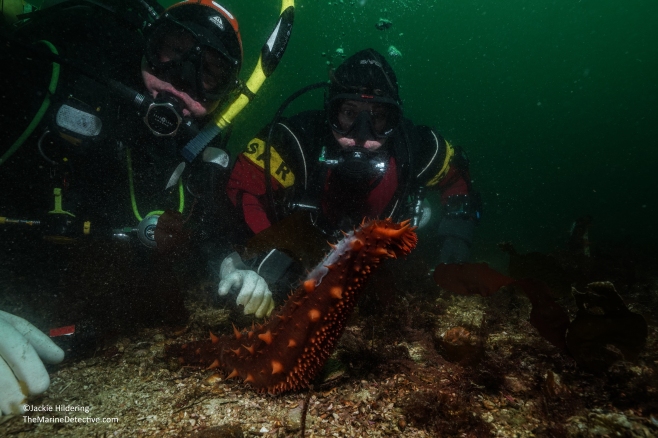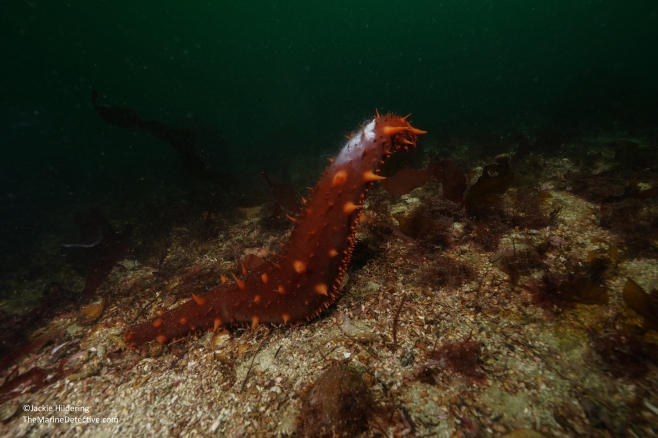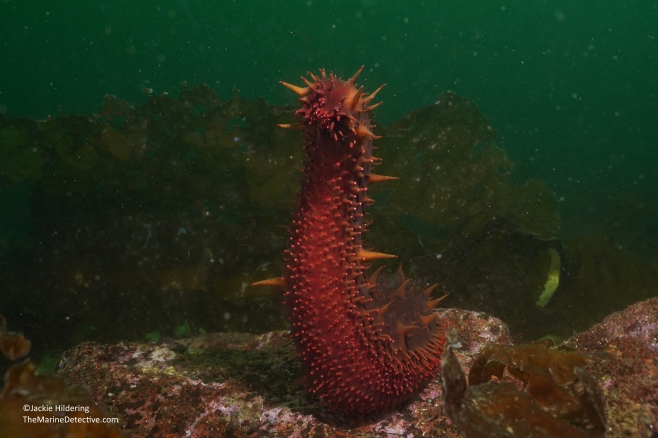Reaching New Heights? A Sea Cucumber Mystery.
This is an open case; one that has me bemused and amused.
While diving near the Great Bear Rainforest in Jackson Narrows, my buddy Tavish Campbell came upon a Giant Sea Cucumber in this very unusual position (Apostichopus californicus, aka California Sea Cucumber).
It was stretched straight up and down, head end up.
As you likely know, this species is most often horizontal; “face” down cruising up to around 4 meters a day along the ocean bottom, mopping up nutritious particles with mucus-covered bushy white tentacles. When there is good stuff stuck on the tentacles, these retract into the mouth (with sandy casts coming out the other end).

A Giant Sea Cucumber in its usual position, horizontal so that it can feed by mopping up particles. This one has a nudibranch crossing over it (Flabellina trophina). ©Jackie Hildering
So why would this individual assume such a remarkably vertical position? Could it be feeding related? It was extending and retracting its mouth tentacles repeatedly but clearly this was not effective in gathering any snacks.

Giant Sea Cucumber with buddy Tavish Campbell. Mouth tentacles extended. Note all the tube feed revealing its relatedness to sea stars and sea urchins (phylum Echinodermata). ©Jackie Hildering
My best hypothesis is that this was mating related. Giant Sea Cucumbers have separate sexes and rise up in a python-like position to release their sex cells (see figure below from A Snail’s Odyssey). This pose reduces the number of sex cells that settle to the ocean bottom, unfertilized.

Giant Sea Cucumbers spawning in python-like pose. Source: A Snail’s Odyssey.
Additional strategies to enhance the chances of fertilization are to twist back and forth and/or intertwine with a partner while releasing gametes. (This species will also catapult back and forth when trying to escape predation by Sunflower Stars).
Striving to ensure your DNA gets passed on does not happen randomly however. As with all broadcast spawners, there is a cue so that the release of sex cells is coordinated. (See my other blog “Sea of Love – Broadcast Spawning“). Giant Sea Cucumbers are known to mate in the shallows from April to August repeatedly “dribble spawning”.
Our high-reaching Giant Sea Cucumber friend was indeed in the shallows and it was significantly warmer there. Was the temperature a cue that it was time to mate? Was s/he trying to sense the presence of a partner or others of his/her kind already broadcasting?
Was s/he reaching to new heights to allow even better distribution of sex cells than the python pose?
Was this individual even old enough to mate as they do not sexually mature till age 4? It’s size certainly suggested it was older since maximum size for the species is reported to be 50 cm.
Had we had more air we could have waited and likely concluded what was up with this behaviour.
As is so often the case however I surfaced with even more questions and a greater sense of wonder about the life below. And yes, this time it may be that I was laughing so hard I was sputtering sea water as well.

More on the species’ spawning:
From the University of Oregon: Adult A. californicus reach sexual maturity after four years and will typically migrate to shallow waters to spawn from late April to August (Lambert 1997) . . . During spawning, A. californicus will lift the anterior one-third to one-half of the body in a cobra-like manner and release strings of white sperm or light orange eggs from the gonophore just behind the dorsal tentacles (Lambert 1997). The eggs are small and negatively buoyant. Fertilization occurs in open water, and large females typically have fecundities up to 8.92 x 106 (Strathmann 1987).
Larva: Apostichopus californicus is the only local species with pelagic planktotrophic development in which a feeding larva develops in the plankton (Strathmann 1987). This development includes a feeding auricularia larva that swims from 35-52 days (Strathmann 1987).
From A Snail’s Odyssey: “The gametes stream from a single gonopore within the ring of tentacles and fertilisation takes place in the open water. The eggs are relatively large and yolky in sea cucumbers, and develop to a feeding larval stage known as an auricularia. After a 3 to 5 week period floating in the plankton, the larvae metamorphose and settle to the sea bottom.”

Two Giant Sea Cucumbers in spawning position, April 2021 ©Jackie Hildering. The orange animals are Orange Sea Cucumbers and they were spawning too and what a spectacular spectacle that is.
Sources / more information:
- A Snail’s Odyssey; Learn About Sea Cucumbers
- Giant Sea Cucumber Walla Walla Edu
- University of Oregon – Apostichopus californicus
- The Marine Detective: Sea of Love – Broadcast Spawning
The following photos were added April 1, 2024.
















